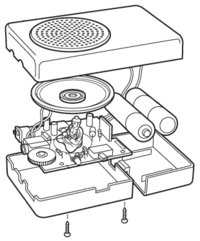 Music
Music
FM3 – Buddha Machine
Label: Staalplaat 2006 $22.99
http://www.staalplaat.com
Reviewed by Bo Young
FM3 is an electronic act based in China, an act known primarily for a (very) minimalist bent and, apparently, their ability to subdue live crowds into absolute Alpha-wave silence. As such, it only makes sense that they be the act to introduce Staalplaat’s Buddha Machine series. The Buddha Machine is a unique sound box, made in China (isn’t everything these days?) that comes with an integrated speaker, a volume control, mini jack-out…even two AA batteries…and a switch to choose between nine different loops stored on a small chip and can be directly played by…and only by…this mini sound system.
The Buddha Machine is ambient music. If you ever listened to flautist Paul Horn’s classic Taj Mahal recordings you are halfway there. It’s background music, but it is also art form in and of itself. The music, that never stops, relaxes you and stimulates you at the same time. And, it’s a nice little adult toy that you will like to hold in your hands, play with and carry it with you.
It’s a little plastic box that plays music. FM3 composed (constructed?) these nine drones (or so we are told…it’s kind of hard to count them, I keep drifting off or I go off into some creative jag when I am listening to it. I can’t swear to the nine) that vary from two seconds to forty-two seconds; they repeat endlessly in the listener’s ear until the "track" is switched to the next drone (or the two AA batteries run out).
The machine has (is?) its own built-in speaker, in case one would like to fill a room with the drones, but there is also a headphone jack for more personal meditative experiences. There’s a switch on the side that allows for traversal of the tracks, and a DC jack (no AC adapter) for those who would like the Buddha Machine experience be truly endless. In a way, it’s like the cheapest pre-loaded iPod you’ll ever be able to buy. It even comes in different colors, displayed minimally on the side of the lotus bedecked, blue box in which the box comes. Seven colors. (Mine’s a monkish saffron). Nine drones. Having only purchased one of these (well, two if you don’t count the one I had sent to Dan) I can’t verify that every Buddha Machine has the same content. Somehow I’d like to imagine they don’t. Collect them all!
At its minimalist little heart (see illustration), however, the Buddha Machine flies in the face of the downloading—if not the collecting—age. First: the entire point of the release is to have the little box.
Sure, theoretically you could download each of the drones (available in mp3 form on FM3’s website), set "repeat" in your media player of choice, and have something close to the original effect, but you lose much of the effect, the “aura,” if you will, of the work that way—evaluating the drones purely on the basis of their musical merit is entirely different than evaluating them as an aspect of an odd little artifact. Second: the sound of the drones via the machine is, in fact, very, very lo-fi; there is an audible buzz in the speaker as the volume gets higher, not to mention a fair amount of hiss that accompanies the drones at any volume. An argument could be made that the constant hiss and crackle is a part of the music (much as the point of John Cage’s 4’33" is not the silence, but the sounds surrounding that silence), lending a bit of entropy to the largely static drones.
All of this is not even to mention the idea that in an age where "how much have you got?" is at least as important a question as "how good is it?", an entire release that contains just under three minutes of unique sound is quite the rara avis.
The drones themselves are largely wonderful, whether carefully studied or relegated to the background. Most of the drones are (if my online translation skills don’t fail me) named after animals and musical instruments, with a couple given the nondescript names of "b1" and "b2", and the final drone named after the verb "To Dance.” The first drone, translated "Horse," is particularly lovely, two repeated organ-like tones that last about fifteen seconds each, which after a while create a lovely, moody, minor-key atmosphere. "Sheep" actually features a melody, that when repeated for a couple of minutes, becomes one of the most peaceful of the drones for its simplicity and use of empty space. Even "b1," (that’s “be-one”…or is it “bone?”) composed with a single, decaying chord only six seconds in length, could slow your heartbeat with its insistence on never, ever moving. The process itself is mesmerizing. I would listen to a drone—for who knows how long?—and then switch the little side switch, back or forth, switching from one drone to the next. Like I said…there are, reportedly, nine of them. I can’t quite count that high when I listen to this…this…box…
The Buddha Machine is more than a little novelty. That’s part of its charm. You can have a little pink (or red, or black, or orange) box that plays ambient music. You can display it. People will ask about it. It’s an icebreaker. But what’s truly special about it is what FM3 has done with a tiny bit of recording space on a little speaker. It’s mesmerizing. It’s portable relaxation. And if you’ve read this far, admit it—you know you want one.
Buddha Box is available one line at Jazz Loft or at Amp Camp at Amp Camp
Bo Young is Publisher and Editorial Director of White Crane.